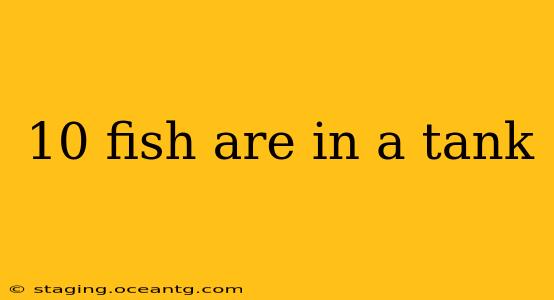10 Fish in a Tank: Exploring the Possibilities and Practicalities
The simple statement "10 fish are in a tank" opens up a world of possibilities, from the practical considerations of aquarium keeping to the metaphorical interpretations of this seemingly straightforward scenario. This post will delve into various aspects of this statement, answering common questions and offering insights for both seasoned aquarists and curious minds.
What kind of fish are they?
This is a crucial question! The type of fish significantly impacts the tank's size, setup, and maintenance. Ten goldfish, for instance, require a vastly larger tank than ten tiny neon tetras. Goldfish are prolific waste producers and need ample space to thrive. Neon tetras, being schooling fish, ideally need a larger tank for their social needs, even if their individual space requirements are smaller. Knowing the species is essential for responsible fishkeeping.
How big is the tank?
The size of the tank is paramount to the fish's well-being. Overstocking a tank leads to poor water quality, increased stress on the fish, and ultimately, disease and death. A general rule of thumb is to provide ample space for each fish to swim comfortably. The specific requirements will depend entirely on the species of fish in the tank. Researching the individual needs of each species before bringing them home is vital.
What are the tank conditions?
Beyond size, the water parameters are equally important. Temperature, pH, ammonia, nitrite, and nitrate levels must all fall within the acceptable range for the fish inhabiting the tank. Regular water changes and monitoring of these parameters are crucial for maintaining a healthy environment. Ignoring these factors can lead to serious health problems for the fish.
Is the tank properly filtered and aerated?
Proper filtration and aeration are essential for removing waste products and ensuring adequate oxygen levels in the water. A well-maintained filtration system prevents the buildup of harmful toxins, contributing significantly to the fish's health and longevity. Sufficient aeration ensures the fish have enough oxygen to survive and thrive.
What other inhabitants are in the tank?
Are there any plants, snails, or other creatures sharing the tank with the ten fish? This influences the overall ecosystem within the tank. Live plants, for example, can help improve water quality and provide hiding places for the fish. Snails can assist in cleaning algae, but too many can overpopulate the tank. Understanding the interaction between all tank inhabitants is critical for successful aquarium management.
What are the signs of a healthy fish tank with 10 fish?
A healthy tank will exhibit clear, clean water, active and alert fish, and the absence of any foul odors. The fish should display normal swimming behavior, feeding habits, and vibrant coloration. Regular monitoring of the water parameters will confirm that the environment is suitable for the fish. A healthy tank is a testament to responsible fishkeeping.
How much does it cost to keep 10 fish?
The cost of maintaining a tank of ten fish can vary significantly depending on the species, tank size, and equipment. Initial setup costs include the tank itself, filter, heater, substrate, decorations, and the fish. Ongoing expenses include food, water testing supplies, and occasional maintenance or repairs. It’s crucial to factor these costs into the decision of acquiring fish.
This exploration demonstrates that the seemingly simple statement "10 fish are in a tank" necessitates a deeper understanding of responsible fishkeeping. The well-being of these animals depends on careful consideration of various factors, ensuring their thriving environment.
